You’re likely losing more precious metal than you realize with each casting cycle. Between oversized sprues, inefficient recycling practices, and poor metal calculations, even experienced jewelers can waste 15-30% of their raw materials without proper waste reduction strategies. The difference between profitable casting and breaking even often comes down to implementing precise measurement techniques and understanding how metal behaves during the entire casting process—starting with your very first calculation.
Calculating Precise Metal Requirements for Each Cast
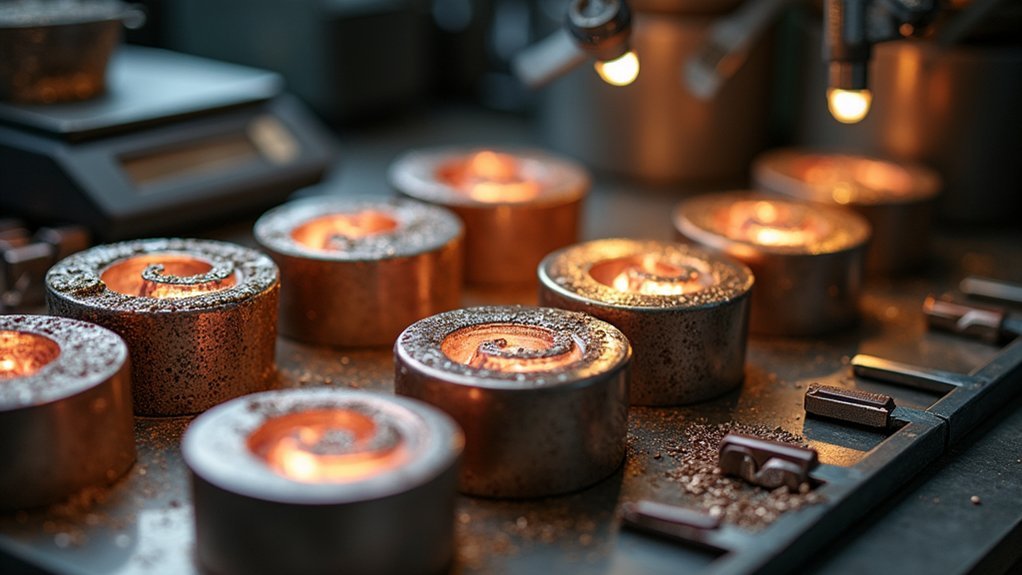
Before you begin melting your precious metals, you’ll need to calculate exactly how much material each cast requires. Start by weighing your wax model along with all attached sprues to establish your baseline measurement.
For greater accuracy, measure the wax model’s volume and multiply it by your metal’s specific gravity. Use this formula: Metal Weight = (Wax Model Volume x Metal Density) + Sprue Weight.
Always add 10-20% extra metal to account for feeding the mold during solidification. This guarantees you’ll have sufficient material to push metal into the mold completely.
Adding extra metal beyond your calculated needs ensures complete mold filling and prevents costly casting failures during the solidification process.
Properly sizing your sprues reduces waste by optimizing flow without requiring excessive quantities. This methodical approach prevents costly overestimation while assuring successful casting results.
Optimizing Sprue and Button Design to Reduce Material Loss
Once you’ve determined your metal requirements, focus on designing an efficient sprue system that minimizes waste throughout the casting process.
Your sprue design directly impacts material efficiency by controlling metal flow and reducing turbulence. Use larger diameter sprues with tapered cone shapes to prevent turbulent pouring that creates defects and waste.
Implement feeder sprues that solidify after your main casting, acting as metal reservoirs to compensate for shrinkage without excess material.
Keep sprue lengths minimal while maintaining proper flow dynamics to reduce metal loss in the sprue system.
Conduct statistical testing on various sprue and button configurations to identify ideal designs that lower scrap rates.
Calculate exact metal quantities based on your model and sprue weights to prevent over-pouring and minimize recyclable excess material.
Implementing Efficient Gold Recycling and Cleaning Methods
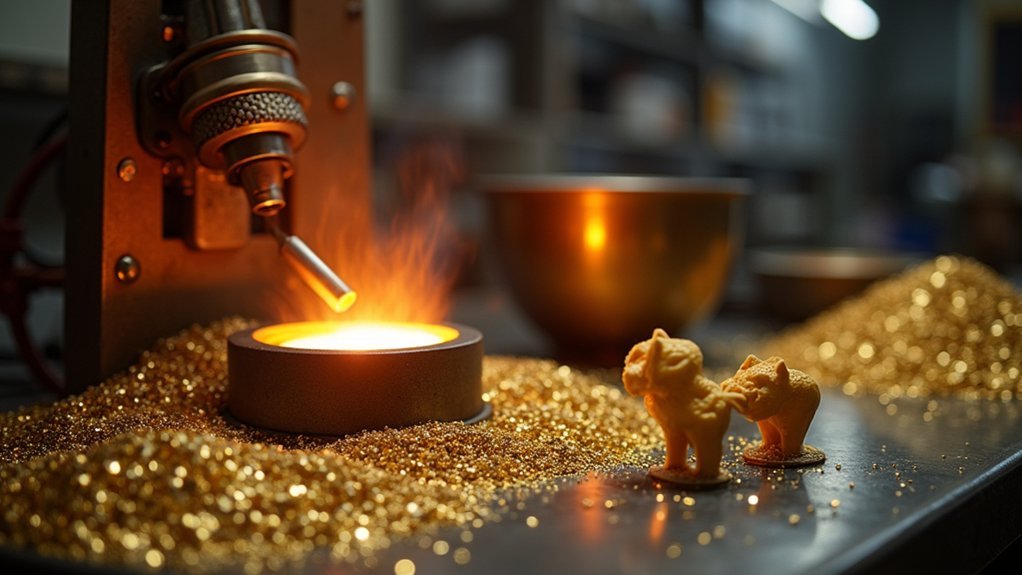
You’ll need to incorporate gold refresher additives into your recycling process to restore the metal’s casting properties after multiple uses.
Consider learning home refining techniques that allow you to purify contaminated gold without relying on outside services.
Adding deox grain to your molten metal provides significant benefits by removing oxygen and other impurities that accumulate during repeated melting cycles.
Gold Refresher Additives
While gold refreshers promise to extend your 14K gold’s casting life, their effectiveness varies considerably between manufacturers and formulations.
These gold refresher additives claim to restore depleted elements and improve casting efficiency, but you shouldn’t rely on them entirely. You’ll get better results combining refreshers with proven recycling practices rather than using them as standalone solutions.
- Test different refresher brands with small batches to determine which works best with your specific 14K gold alloy
- Add fresh metal alongside refreshers after every 3-4 castings to maintain ideal quality standards
- Monitor porosity levels in your castings when using refreshers to verify they’re actually improving results
- Keep detailed records of refresher usage to track casting efficiency improvements or degradation patterns
Home Refining Techniques
Although refreshers can help extend your gold’s usable life, proper home refining techniques will give you consistently better results when recycling 14K gold for casting.
Start by cleaning old buttons and sprues using ultrasonic cleaning in a dedicated container to remove contaminants effectively. Before melting, treat your gold pieces with pickle solution to eliminate oxidation and prepare the metal for ideal casting.
For persistent defects on old buttons, use a brass brush in your flex shaft to restore quality. Track each pour by marking your gold after every casting cycle to prevent overuse.
When preparing for jewelry casting, add fresh metal to your recycled gold mix. This prevents porosity and casting defects that compromise your casting wax impressions.
Deox Grain Benefits
When recycling 14K gold for casting projects, deox grain serves as an essential additive that maintains metal purity and prevents firescale formation during the melting process.
You’ll find this powerful additive extends your casting cycles by minimizing porosity and enhancing overall piece quality. Combined with proper ultrasonic cleaning and pickle solutions, deox grain considerably improves your recasting results from old gold materials.
- Reduces waste – Minimizes porosity in sprues and buttons, allowing more reuse cycles
- Enhances quality – Maintains 14K gold purity while preventing oxidation damage
- Improves efficiency – Extends casting life of recycled materials considerably
- Optimizes inventory – Better gold management leads to improved cash flow and sustainability
Stay updated on your suppliers’ deox grain recommendations to maximize casting effectiveness and reduce material waste.
Selecting Appropriate Casting Techniques for Maximum Efficiency
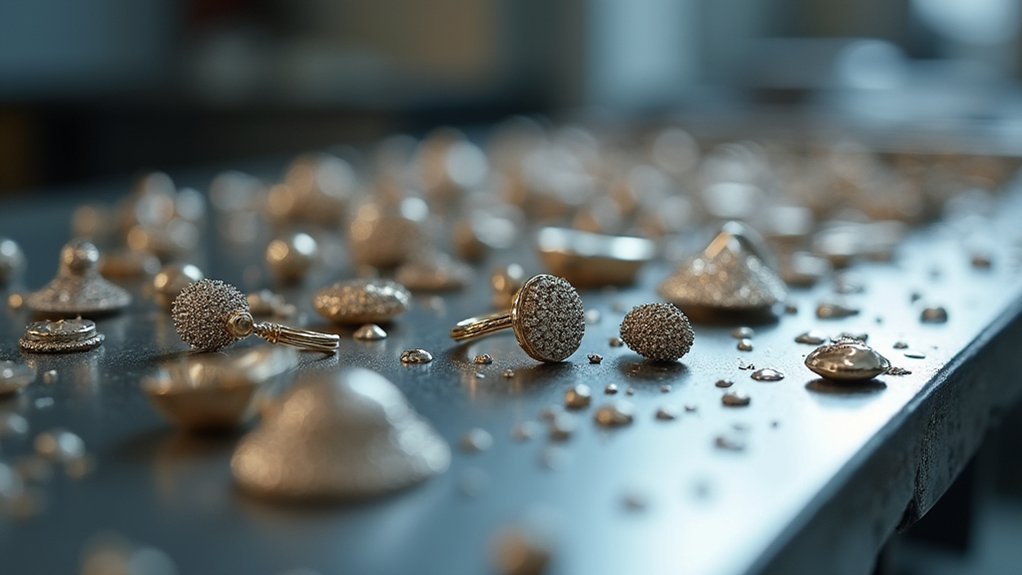
Since efficiency directly impacts both your material costs and production time, selecting the right casting technique becomes crucial for successful jewelry making.
You’ll want to choose centrifugal casting for smaller pieces, as it provides precise control over molten metal flow while minimizing waste through reduced turbulence during pouring.
Design tapered sprues to enhance feeding efficiency and guarantee smooth molten metal delivery into mold cavities.
When setting up casting trees, arrange pieces strategically to optimize metal distribution and reduce excess material.
Select investment mixes tailored to your model’s weight and size for accurate measurements that prevent waste.
Implement systematic inventory management to track castings and gold quantities used in sprues and buttons.
Regularly assess your techniques based on results to continuously improve efficiency.
Managing Investment Materials and Flask Preparation
Proper investment material management forms the foundation of successful jewelry casting, as it directly affects both casting quality and material costs.
You’ll need to weigh your wax model with sprues to calculate precise investment powder amounts using a 1:1.5 powder-to-water ratio.
Key steps for ideal flask preparation:
- Mix investment materials thoroughly to achieve smooth consistency without lumps
- Use a vacuum chamber to eliminate air bubbles that cause casting defects
- Secure your wax model to the flask bottom with melted wax for stability
- Pour investment mixture carefully to encase the model without overfilling
After the investment mold dries, inspect it for cracks or imperfections before proceeding.
This prevents casting failures that waste materials and time.
Monitoring Metal Quality Through Multiple Casting Cycles
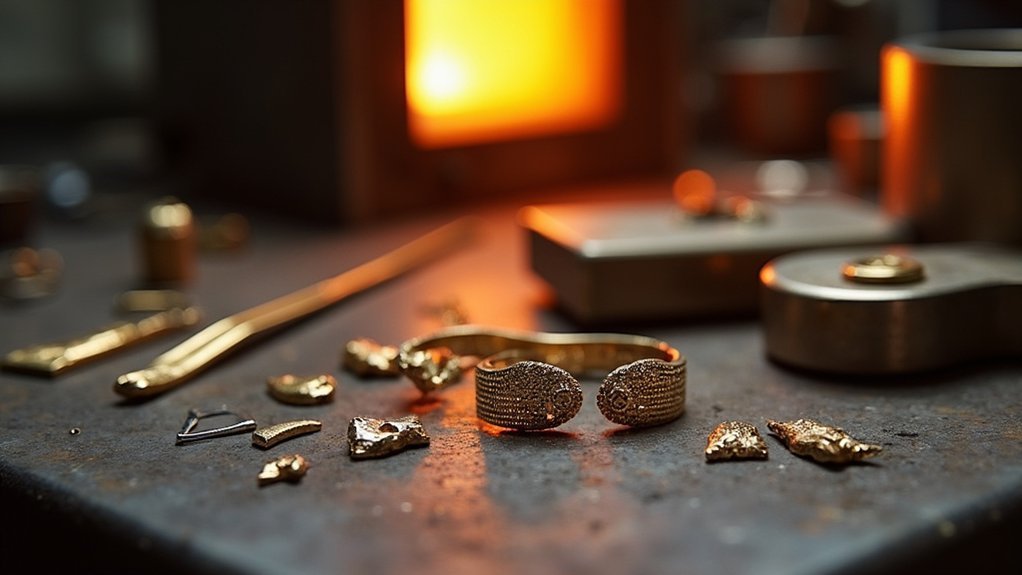
Although your investment preparation creates the mold, the metal you pour into it determines your final piece’s quality and longevity.
You can reuse 14K gold only twice before adding 50% new gold to maintain proper metal quality and prevent porosity. Track how many times you’ve used each batch—repeated casting creates darkened films that make polishing difficult and signal compromised integrity.
Clean your recycled gold thoroughly with ultrasonic baths and pickle solutions before each pour. This prevents contamination and guarantees better casting results.
While gold refreshers might extend your metal’s usability, question their reliability with suppliers regarding purity standards.
Monitor your sprues and buttons carefully. Efficient tracking minimizes waste while maintaining the high standards your jewelry demands through multiple casting cycles.
Strategic Planning for Batch Casting Operations
You’ll maximize casting efficiency by calculating precise metal quantities through careful weighing of your wax models and sprues before each pour.
Smart sprue design reduces material waste while ensuring proper metal flow, directly impacting your bottom line and material costs.
Implementing a systematic approach to recycling cast materials lets you maintain gold quality standards while minimizing fresh metal purchases across multiple casting cycles.
Metal Quantity Calculations
When calculating metal quantity calculations for casting, start by weighing your wax model and sprues together to establish your baseline requirements.
You’ll need to account for metal density, expected shrinkage during cooling, and the volume displacement of your wax pieces. This precise approach guarantees you have adequate liquid metal without excessive waste.
For batch casting operations, calculate the cumulative weight of all pieces being cast simultaneously. This optimization reduces waste from sprues and buttons while maximizing your furnace efficiency.
- Use a systematic formula incorporating wax weight, metal density, and shrinkage rates
- Document metal usage from each casting session for future reference
- Adjust calculations based on previous casting outcomes and results
- Consider sprue systems and button requirements in total metal calculations
Sprue Design Optimization
Since proper sprue design directly impacts both casting quality and metal efficiency, you must strategically plan each element to maximize your batch operations.
Your sprue design optimization begins with sizing sprues appropriately—use larger sprues for bigger models to guarantee adequate precious metal flow and prevent plugging. Align sprues carefully to avoid flow restrictions that create unusable castings.
Design feeder sprues that solidify after your main pieces, creating reservoirs that compensate for shrinkage and reduce waste. Incorporate tapered cone shapes at pouring openings to minimize turbulence and improve flow quality, decreasing defect-related waste.
Regularly weigh your model and sprue configurations to calculate precise precious metal quantities needed. This systematic approach eliminates excess material while guaranteeing consistent, high-quality results across your entire casting batch.
Recycling Cast Materials
After completing your casting operations, establishing an efficient recycling system becomes essential for maintaining material quality and controlling costs throughout your production cycles.
Recycling cast materials requires systematic tracking to prevent degradation from excessive reuse. You’ll need to monitor how many times your old gold has been cast, as quality deteriorates beyond two cycles without proper intervention.
- Implement a tracking system to log casting cycles and identify when fresh gold should be introduced
- Use ultrasonic cleaners and pickle solutions to thoroughly prepare old gold before each recasting operation
- Invest in gold refreshers or deox grain to maintain 14K gold purity throughout multiple casting cycles
- Reduce batch sizes to minimize waste from sprues and buttons while maximizing material efficiency
Strategic pricing should reflect recycling costs and labor investment.
Finishing Techniques That Preserve Raw Materials
Although casting jewelry requires significant investment in precious metals, you can preserve these valuable raw materials through strategic finishing techniques that minimize waste. When you Cast Jewelry, every gram of precious metal matters, so implementing proper finishing techniques protects your investment.
Start by using a burr to remove imperfections from cast pieces, creating clean finishes without excessive material removal. Clean plaster residue with acid baths to maintain raw material integrity. Remove sprues using angle grinders with cut-off wheels to minimize metal loss.
| Technique | Tool | Benefit |
|---|---|---|
| Burr removal | Hand burr | Clean finish, minimal waste |
| Cleaning | Acid bath | Preserves material integrity |
| Sprue removal | Angle grinder | Reduces metal loss |
| Polishing | Buffing wheel | High shine, weight preservation |
| Inventory tracking | Management system | Optimized gold usage |
Track gold inventory carefully to optimize melting quantities per session.
Frequently Asked Questions
What Is the Lost Wax Method of Casting?
You create a detailed wax model, encase it in hardening investment material, then melt out the wax in a kiln, leaving a hollow mold you’ll fill with molten metal.
How Thin Can You Cast Gold?
You can cast gold as thin as 1-2 millimeters safely for most jewelry pieces. While you’re able to go thinner, you’ll risk brittleness and porosity. Advanced vacuum casting techniques help you achieve thinner sections successfully.
Do You Need a Vacuum for Lost Wax Casting?
You don’t strictly need a vacuum for lost wax casting, but you’ll get considerably better results with one. It eliminates air bubbles, improves surface finish, and reduces casting defects for professional-quality pieces.
What Is the Easiest Metal to Cast Jewelry?
You’ll find pewter’s the easiest metal for casting jewelry since it melts at just 170-230°C. Aluminum’s also beginner-friendly with its low 660°C melting point and excellent flow properties for detailed work.
In Summary
You’ll maximize efficiency by combining precise calculations with smart recycling practices. Weigh your models accurately, design tapered sprues, and maintain detailed records of each cast. Don’t forget to refresh your gold regularly and plan batch operations when possible. By monitoring metal quality throughout multiple cycles and implementing proper finishing techniques, you’ll consistently reduce waste while maintaining high-quality results. These practices will transform your casting workflow into a sustainable, profitable operation.

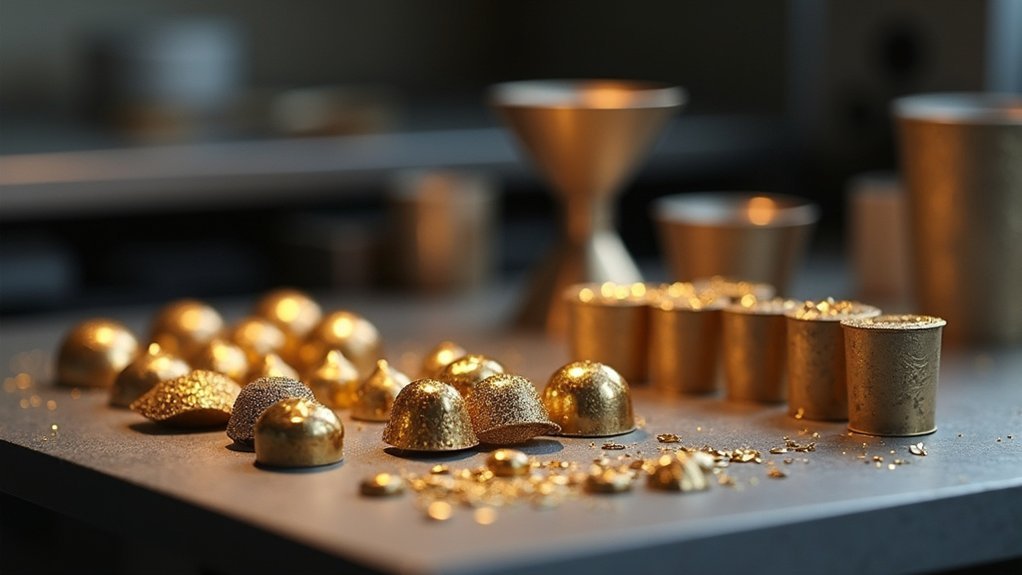



Leave a Reply